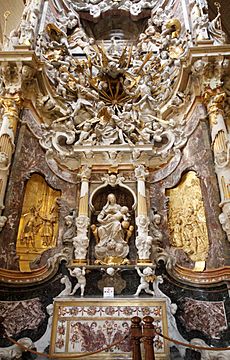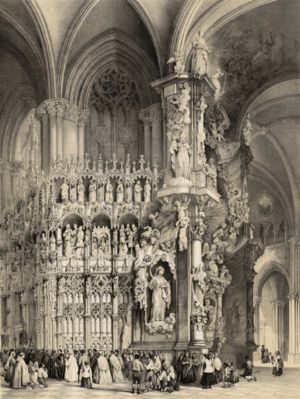El Transparente facts for kids
El Transparente is a stunning piece of art found in the Cathedral of Toledo in Spain. It's a special kind of altarpiece from the Baroque period. Its name, "El Transparente," means "The Transparent One." This is because of a clever design that lets sunlight shine through it.
This artwork was built between 1729 and 1732. It was created by an artist named Narciso Tomé and his four sons. His sons were skilled in different areas: two were architects, one was a painter, and one was a sculptor. They used many different materials like marble, bronze, paint, and stucco to make it. Some experts believe its use of light and mixed materials was inspired by Bernini's famous Cathedra Petri in St Peter's Basilica in Rome.
Why Was El Transparente Built?
The creation of El Transparente was ordered by Diego de Astorga y Céspedes, who was the Archbishop of Toledo. The Archbishop wanted to create a magnificent monument to highlight the presence of the Holy Sacrament.
This amazing artwork was very expensive, costing about 200,000 ducats. When it was finished, people were incredibly impressed. Some even called it 'the Eighth Wonder of the World' in a special poem! Cardinal Astorga y Céspedes is buried right in front of El Transparente.
How Does the Light Work?
The American writer James Michener explained how the light works in his book Iberia (1968). The main altar of the cathedral was very tall, which kept the tabernacle (a special container for the Blessed Sacrament) in constant shadow.
To fix this, two holes were made. First, a large skylight was cut high up into the thick back wall of the cathedral. This wall is behind the main altar. Second, another hole was cut directly into the main altar itself. This allowed beams of sunlight to pass through and shine like a spotlight on the tabernacle.
The Amazing Design
After the two holes were made, Narciso Tomé and his sons designed the artwork to connect them visually. They sculpted many figures, including angels, saints, prophets, and cardinals. These figures seem to tumble down from the skylight into the cathedral.
They also added abstract designs that look like flowing robes and leaves. These designs help to hide the details of the holes cut into the walls. At the very top of the opening, you can see Christ sitting on clouds, surrounded by angels. The back of the altarpiece was turned into a tall marble tower that reaches from the floor to the ceiling. All these detailed figures were carefully placed so that the opening to the tabernacle was hidden, but the light could still shine through.
See also
In Spanish: Transparente de la catedral de Toledo para niños



